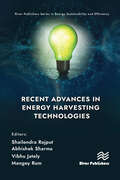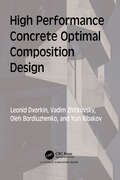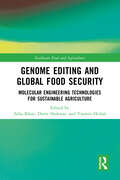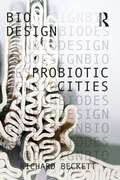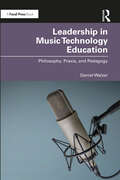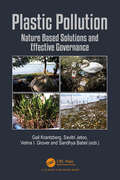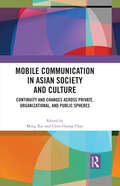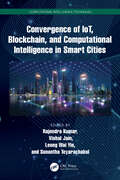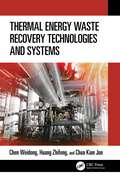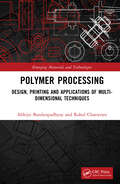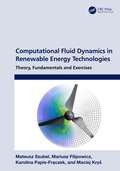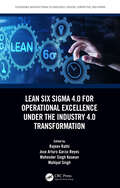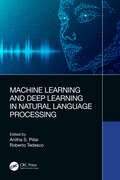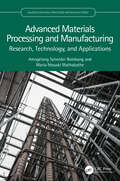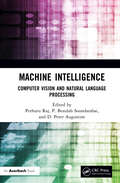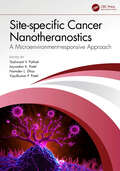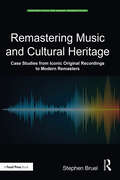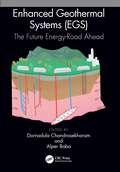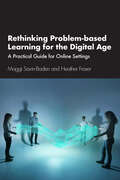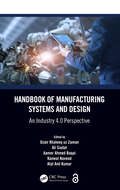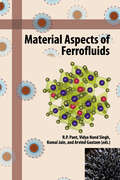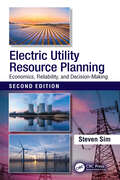- Table View
- List View
Recent Advances in Energy Harvesting Technologies (River Publishers Series in Energy Sustainability and Efficiency)
by Mangey Ram Abhishek Sharma Vibhu Jately Shailendra RajputEnergy demand is continuously rising, mainly due to population growth and rapid economic development. There are substantial worries about the environmental effects of fossil fuels in addition to the uncertainties surrounding the long-term sustainability of non-renewable energy sources. Environmental safety concerns are driving an increase in the demand for renewable energy production. Numerous efforts have been paid to harvest energy from ambient sources, e.g. solar, wind, thermal, hydro, mechanical, etc. This book discusses the application of artificial intelligence (AI) for energy harvesting. The implementation of metaheuristics and AL algorithms in the field of energy harvesting system will provide a quick start for the researchers and engineers who are new to this area. Energy harvesting technologies are growing very speedily, hence it is necessary to summarize recent advances in energy harvesting methodology. Over the recent years, a considerable amount of effort has been devoted, both in industry and academia, towards the performance modelling and evaluation of energy harvesting technologies. This book is the result of a collaborative effort among different researchers in the fields of energy harvesting and artificial intelligence. Technical topics discussed in the book include: Hybrid algorithms Mechanical to electrical energy conversion Swarm intelligence MPPT technologies Polymer nanocomposites
High Performance Concrete Optimal Composition Design
by Leonid Dvorkin Vadim Zhitkovsky Yuri Ribakov Oleh BordiuzhenkoConcrete and reinforced concrete remain the main building materials for construction of modern fortifications. The book presents experimental and theoretical results allowing production of special high-strength rapid hardening concrete and fiber reinforced concrete. It describes a method for effective proportioning of high-strength fast-setting concrete and fiber reinforced concrete with high dynamic strength as well as selecting proper technological parameters, methodology for design of reinforced concrete structures using such concrete. Particular attention is paid to ensuring the early strengthening of concrete within 24 hours after casting and to constructing structures with limited energy resources at the site.
Genome Editing and Global Food Security: Molecular Engineering Technologies for Sustainable Agriculture (Earthscan Food and Agriculture)
by Zeba Khan Durre Shahwar Yasmin HeikalWith the rapid increase in the global population and changing climatic impacts on agriculture, this book demonstrates how genome editing will be an indispensable technique to overcome ongoing and prospective agricultural challenges. This book examines the role of genome editing in improving crop yields and contributing to global food security. It summarizes a range of genome editing techniques and discusses the roles they can play in producing a new generation of high-yielding, climate-ready crops. This includes site-specific nucleases, precision genome engineering, clustered regularly interspaced short palindromic repeats, and bioinformatics. It showcases how these gene editing techniques can tailor plants to not only increase yield-related traits but to also make them better suited to their environment and to be resistant to pests and extreme climatic events, such as droughts. The book also examines genome editing regulations and policies, the commercialization of genome-edited crops, and biosafety and biosecurity concerns. Overall, this book reveals and showcases how genome editing can improve crop resilience and production to address current and future agricultural challenges and alleviation of global food security concerns. This book will be of great interest to students and scholars of agricultural science, crop and plant science, genome editing, sustainable agriculture, biotechnology, and food security.
Probiotic Cities (Bio Design)
by Richard BeckettProbiotic Cities covers a body of work that is at the forefront of emerging knowledge within architecture, towards designing informed indoor and built environment microbiomes. Sited within the broader field of Bio Design, the book presents highly experimental design research at the intersection of architecture, engineering and microbiology. The book describes work which explores novel strategies towards directly (re)introducing beneficial microbes into buildings and cities. Through discussion of both the work and the processes and methodologies used, it provides a framework to enable designers and practitioners to begin to engage with contemporary human–microbe relationships towards the design of healthy and resilient cities. The book defines a new microbial paradigm for architecture that engages with broader emerging ecological or ‘more than human’ philosophies for design within the age of the Anthropocene.
Leadership in Music Technology Education: Philosophy, Praxis, and Pedagogy
by Daniel WalzerLeadership in Music Technology Education examines the pedagogical, sociocultural, and philosophical issues that affect curriculum, research, and decision-making in music technology in higher education. This book considers a range of cutting-edge topics, including the impact of the COVID-19 pandemic, professional development concepts, partnerships between higher education and the creative and cultural industries, and the effects technology has on sustainability. Drawing on Leadership theories, including Transformational, Situational, Servant, and Social Change Model Theory, the book puts forward a new model, Creative Industry Leadership, which considers the sociocultural aspects of Music Technology Education, and interrogates biased ideologies that limit opportunities for a broad range of learners and practitioners in education and beyond. Additionally, Leadership in Music Technology Education examines educators’ informal leadership capacities during the COVID-19 pandemic and how inclusive pedagogy expands the creative boundaries of teaching, learning, and music-making for all. Leadership in Music Technology Education is crucial reading for instructors teaching audio engineering and music technology, as well as researchers in education, music pedagogy and related fields. This is also a valuable read for anyone with an interest in music technology and its many potentialities.
Plastic Pollution: Nature Based Solutions and Effective Governance (Water)
by Velma I. Grover Gail Krantzberg Sandhya Babel Savitri JetooPlastics show up in every area of our lives. They are durable, cheap and light, properties that make them attractive but also problematic for the environment. The focus of this book is not just to highlight the problem of plastics, its definition, and how plastic pollution is impacting human health and environment but also to look at some best practices in both nature based solutions and in the field of law and policies. The first section of the book focuses on plastic pollution – it’s origin, relationship to climate change, linear/circular economy, followed by sustainable plastics, scientific solutions, and how policies can address plastic pollution. This includes looking at better designs, more sustainable feedstocks, and partnerships between various stakeholders worldwide including USA, China, Canada, South Korea, Thailand. This book will interest those who are associated with the production industry, packaging industry, and waste management industry as well as, academicians, students and policymakers.
Mobile Communication in Asian Society and Culture: Continuity and Changes across Private, Organizational, and Public Spheres
by Ming XieXie and Chao present a collection of research on mobile communication in Asian communities and countries such as Bangladesh, China, India, Japan, and South Korea. With chapters written by scholars from diverse cultural and institutional backgrounds, this book provides both localized and comparative perspectives on mobile communication research. Exploring the way mobile apps are used in daily life in Asian countries, Xie, Chao, and their contributors analyze how mobile apps improve lives, help people build relationships, sustain communities, and change society for the better. They look at areas including the role of mobile apps in public service delivery and access, family communication, cultural norms and identities, organizational communication, and intercultural communication. The investigation of these topics elevates the understanding of the cultural, familial, interpersonal, organizational, and intercultural consequences of mobile communication in a global context. Through examining mobile apps use in regard to scale, scope, depth, complexity, and distinctiveness within the Asian context, this book furthers the research agenda of mobile communication and enriches our understanding of current practice and future direction of mobile communication. This book serves as a useful reference for scholars and students interested to learn more of the development and application of mobile communication from a global and comparative perspective.
Convergence of IoT, Blockchain, and Computational Intelligence in Smart Cities (Computational Intelligence Techniques)
by Rajendra Kumar Vishal Jain Leong Wai Yie Sunantha TeyarachakulThis edited book presents an insight for modelling, procuring, and building the smart city plan using the Internet of Things (IoT) and a security framework using blockchain technology. The applications of Li-Fi and 5G in smart cities are included, along with their implementation, challenges, and advantages. This book focuses on the use of IoT and blockchain in the day-to-day transparent and recorded activities of citizens of smart cities like, smart citizen management. The future for upgrading the system as per technological advancements is also discussed. This book: integrates IoT, blockchain, Li-Fi, and 5G in smart city implementation covers smart supply chain management using IoT outlines the state-of-the-art and sustainable implementation of smart cities and practical challenges includes sustainable development of smart cities presents detailed explanation of case studies of smart cities of developed countries and developing countries and their comparisons This book is aimed at researchers and graduate students in Artificial Intelligence, Urban Planning, and Information Technology Systems and Management.
Thermal Energy Waste Recovery Technologies and Systems
by Weidong Chen Kian Jon Chua Zhifeng HuangThermal Energy Waste Recovery Technologies and Systems comprehensively covers thermal energy recovery technologies and systems. It considers thermal sources, working principles, products, application status, prospects, and challenges. In an effort to achieve energy security, carbon neutralization, and sustainable development, this book discusses waste recovery from thermal energy technologies and systems from varying temperatures. This book features case studies of advanced multi-generation systems for different industrial applications. This book is intended for senior undergraduate and graduate mechanical engineering students taking courses in thermal energy, energy systems, and renewable energy, as well as researchers studying thermal energy utilization, low-carbon technologies, thermal dynamic analysis, and energy system design.
Polymer Processing: Design, Printing and Applications of Multi-Dimensional Techniques (Emerging Materials and Technologies)
by Abhijit Bandyopadhyay Rahul ChatterjeeThis book covers polymer 3D printing through basics of technique and its implementation. It begins with the discussion on fundamentals of new-age printing, know-how of technology, methodology of printing, and product design perspectives. It includes aspects of CAD along with uses of Slicer software, image analysis software and MATLAB® programming in 3D printing of polymers. It covers choice of polymers for printing subject to their structure–property relationship, troubleshooting during printing, and possible uses of waste plastics and other waste materials. Key Features Explores polymeric material printing and design. Provides information on the potential for the transformation and manufacturing, reuse and recycling of polymeric material. Includes comparison of 3D printing and injection moulding. Discusses CAD design and pertinent scaling-up process related to polymers. Offers basic strategies for improvement and troubleshooting of 3D printing. This book is aimed at professionals and graduate students in polymer and mechanical engineering and materials science and engineering.
The Spirit of Recovery: IT Perspectives, Experiences, and Applications during the COVID-19 Pandemic
by Aji Prasetya WibawaThe scope of this book focuses on how information technology may assist in achieving goals and in providing solutions to problems such as a pandemic. Research on the Internet and on technology has been done, and the findings have applications in various sectors that rely on interdisciplinary knowledge. This book explores and describes state-of-the-art research conducted during the COVID-19 pandemic. Topics covered include the IT viewpoint and the rules governing digital transformation throughout the pandemic. The Digital Revolution sped up by a decade during COVID-19, which impacted both the user experience and that of software developers. As a component of the digital transformation process, this book explores the experiences of both the user and developer when attempting to change and adapt while utilizing an information technology program. This book includes five topics: (1) multidisciplinary artificial intelligence, (2) Smart City and Internet of Things applications, (3) game technology and multimedia applications, (4) data science and business intelligence, and (5) IT hospitality and information systems. Each topic is covered in several book chapters with some application in several countries, especially developing countries. The chapters provide insight from contributors with different perspectives and several diverse fields who present new ideas and approaches to solving problems associated with the worldwide pandemic.
Computational Fluid Dynamics in Renewable Energy Technologies: Theory, Fundamentals and Exercises
by Mateusz Szubel Mariusz Filipowicz Karolina Papis-Frączek Maciej KryśThis book is focused on combining the concepts of computational fluid dynamics (CFD) and renewable energy technologies. Besides introducing the fundamentals, the core of this book contains a series of practical examples providing useful information about the methods and smart solutions for CFD modeling of selected Renewable Energy Sources (RES) - based technologies. Each chapter includes a theoretical introduction to the discussed topic, descriptions of factors determining efficiency and other important parameters, followed by practical information concerning the CFD modeling methodology. A summary of the relevant recommendations and exemplary results with comments is also included. Features: provides practical examples on the application of numerical methods in the analysis of renewable energy processes, includes an introduction to CFD for practitioners, explores selected aspects of the methodology used in CFD simulations of renewable energy technologies, discusses tips and hints for efficient use of CFD codes functionalities, contains additional exercise devoted to the geothermal systems. This book is aimed at professionals and graduate students in energy engineering, renewable energy, CFD, energy systems, fluid mechanics and applied mathematics.
Lean Six Sigma 4.0 for Operational Excellence Under the Industry 4.0 Transformation (Sustainable Manufacturing Technologies)
by Rajeev Rathi Mahender Singh Kaswan Mahipal Singh Arturo Garza-Reyes, JoseThis book presents innovative breakthroughs in operational excellence that can solve the operational issues of smart factories. It illustrates various tools and techniques of Lean Six Sigma 4.0 and details their suitability for manufacturing and service systems. Lean Six Sigma 4.0 for Operational Excellence Under the Industry 4.0 Transformation provides technological advancement in operational excellence and offers a framework to integrate Lean Six Sigma and Industry 4.0. The book is a guide to dealing with new operational challenges and explains how to use Industrial IoT, Sensors, and AI to collect real-time data on the shop floor. While focusing on developing a toolset for Lean Six Sigma 4.0, this book also presents the enabling factors to adopt Lean Six Sigma 4.0 in the manufacturing and service sectors. The book will help industrial managers, practitioners, and researchers on the path of process improvement in modern-day industries.
Machine Learning and Deep Learning in Natural Language Processing
by Anitha S. Pillai Roberto TedescoNatural Language Processing (NLP) is a sub-field of Artificial Intelligence, linguistics, and computer science and is concerned with the generation, recognition, and understanding of human languages, both written and spoken. NLP systems examine the grammatical structure of sentences as well as the specific meanings of words, and then they utilize algorithms to extract meaning and produce results. Machine Learning and Deep Learning in Natural Language Processing aims at providing a review of current Neural Network techniques in the NLP field, in particular about Conversational Agents (chatbots), Text-to-Speech, management of non-literal content – like emotions, but also satirical expressions – and applications in the healthcare field. NLP has the potential to be a disruptive technology in various healthcare fields, but so far little attention has been devoted to that goal. This book aims at providing some examples of NLP techniques that can, for example, restore speech, detect Parkinson’s disease, or help psychotherapists. This book is intended for a wide audience. Beginners will find useful chapters providing a general introduction to NLP techniques, while experienced professionals will appreciate the chapters about advanced management of emotion, empathy, and non-literal content.
Advanced Materials Processing and Manufacturing: Research, Technology, and Applications (Advanced Materials Processing and Manufacturing)
by Amogelang Sylvester Bolokang Maria Ntsoaki MathabatheThis book describes the operations and industrial processes related to the production of advanced materials including ingot and powder metallurgy processing routes. It outlines the deformation processing mechanisms inducing failure at both ambient and high temperatures. Further, it embodies practical knowledge and engineering mechanisms of traditional and unorthodox material disposal approaches, concurrently with gear cutting/ manufacturing and computer numerically controlled machining. The surface fusion of metals in the production of coatings via the process of laser cladding is also covered. Features: Covers novel and multi-variety techniques of materials processing and manufacturing. Reports on the significant variables of the processes and basic operations of advanced materials. Discusses fundamental and engineering machining analysis. Includes novel fabrication of TiAl alloys using both powder and ingot metallurgy routes. Enables critical thinking through technical problem solving of local service manufacturers. This book is aimed at researchers and graduate students in materials and manufacturing engineering.
Machine Intelligence: Computer Vision and Natural Language Processing
by Pethuru Raj P. Beaulah Soundarabai D. Peter AugustineMachines are being systematically empowered to be interactive and intelligent in their operations, offerings. and outputs. There are pioneering Artificial Intelligence (AI) technologies and tools. Machine and Deep Learning (ML/DL) algorithms, along with their enabling frameworks, libraries, and specialized accelerators, find particularly useful applications in computer and machine vision, human machine interfaces (HMIs), and intelligent machines. Machines that can see and perceive can bring forth deeper and decisive acceleration, automation, and augmentation capabilities to businesses as well as people in their everyday assignments. Machine vision is becoming a reality because of advancements in the computer vision and device instrumentation spaces. Machines are increasingly software-defined. That is, vision-enabling software and hardware modules are being embedded in new-generation machines to be self-, surroundings, and situation-aware.Machine Intelligence: Computer Vision and Natural Language Processing emphasizes computer vision and natural language processing as drivers of advances in machine intelligence. The book examines these technologies from the algorithmic level to the applications level. It also examines the integrative technologies enabling intelligent applications in business and industry.Features: Motion images object detection over voice using deep learning algorithms Ubiquitous computing and augmented reality in HCI Learning and reasoning in Artificial Intelligence Economic sustainability, mindfulness, and diversity in the age of artificial intelligence and machine learning Streaming analytics for healthcare and retail domains Covering established and emerging technologies in machine vision, the book focuses on recent and novel applications and discusses state-of-the-art technologies and tools.
Site-specific Cancer Nanotheranostics: A Microenvironment-responsive Approach
by Jayvadan K. Patel Yashwant V. Pathak Namdev L. Dhas Vipul P. PatelThis book addresses various aspects of recent progress in the development of all types of tumorresponsive and site-specific delivery platforms together with the range of related chemistries. It is a timely volume as global research in oncology is moving towards more biochemical signal–based and cell environment–inspired therapeutic strategies. Furthermore, the book emphasizes the need to explore various characterization techniques for specific stimuli-responsive nanoplatforms and toxicological and regulatory aspects. Features • Focused, comprehensive volume providing a different angle on theranostics in cancer intervention. • Targets not only the multifunctionality of nanosystems but provides a comprehensive overview of niche technical aspects. • Given the chemistries presented here, it provides both early-career and experienced readers with strategies from leading authorities in the field globally.
Remastering Music and Cultural Heritage: Case Studies from Iconic Original Recordings to Modern Remasters (Perspectives on Music Production)
by Stephen BruelRemastering Music and Cultural Heritage presents a detailed account of the culture and practice of remastering music recordings. By investigating the production processes and the social, nostalgic and technological components of remastering practice, the book demonstrates the application of these techniques to iconic recordings by artists including The Beatles, Elton John and Oasis. Through comprehensive interviews with music production professionals directly involved in both the original productions and remastered releases of these iconic recordings – and detailed digital audio analysis – this book offers an extensive insight into music production and remastering practice. Readers learn about the music production techniques behind creating some of the most well-recognised and loved albums of all time, as well as the processes used to create the remasters, to help guide their own projects. Remastering Music and Cultural Heritage is essential reading for students and teachers of music production, professional practitioners and musicians.
Enhanced Geothermal Systems (EGS): The Future Energy-Road Ahead
by Alper Baba Dornadula ChandrasekharamPeter Meisen, Past President, Global Energy Network Institute, asked in 1997, “What if there was an existing, viable technology, that when developed to its highest potential could increase everyone’s standard of living, cut fossil fuel demand and the resultant pollution?” After 23 years of sustained effort by the global scientific community, this is becoming a reality. The technology to extract heat from granite has been revolutionized in the last few years. The classical method of creating fracture networks by hydrofracturing is being replaced by a closed-loop method where fluids are not in contact with the hot granite. Supercritical CO2 is replacing water as a circulating fluid. Certainly, the future energy road is going to be led by highly radiogenic granites. While hydrothermal sources are site-specific and have their limitations, EGS can be initiated anywhere on earth. EGS is removing all such obstacles and, in the future, will provide uninterrupted electricity for all. Energy-deficient countries can have surplus electricity; water-stressed countries can have a perennial freshwater supply; and countries can become food-secure and rise above poverty levels. Countries need not depend on energy imports and can independently evolve into carbon neutral or low carbon societies. The contributions made by experts will help researchers and investors to close the energy demand and supply gap in the very near future by tapping the unlimited energy of the Earth. Opportunities available for investors in Turkey are well documented with field, geophysical, and geochemical data and information on the energy generating capacity of the granite intrusive spread over a cumulative area of 6,910 km2 in western Anatolia. With the signing of the Global Geothermal Alliance (GGA) by several countries during the December 2015 CoP 21 (Conference of Parties) summit in Paris, countries are obliged to reduce CO2 emissions by increasing the footprint of renewable energy in the primary source mix. Information provided in this book will lead the way to establishing a clean energy future for millions of people for sustainable development and help to mitigate crises arising due to food, water, and energy shortage issues. Academic and research institutes will benefit to a large extent from the expertise of the top contributors in this book. This information provided in this book will help to lay the foundation for super-hot EGS research in future.
Rethinking Problem-based Learning for the Digital Age: A Practical Guide for Online Settings
by Heather Fraser Maggi Savin-BadenRethinking Problem-based Learning for the Digital Age provides grounded, evidence-based strategies for teaching faculty, academic developers and educational technologists who are changing their problem-based learning (PBL) modules and programmes from face-to-face to online. Given today’s rapid advancements in learning and curriculum development specific to online and blended modes, there is considerable potential to introduce new forms of PBL in higher education. This book applies fundamental and cutting-edge research, including original scholarship by the authors, to innovative PBL practices and realistic tasks that can be brought to life through digital environments, teamwork and resources. Whether re-contextualizing PBL practices for newly online/blended instruction or seeking fresh PBL approaches for existing digital education environments across disciplines, readers will be guided to construct active, highly motivating, learner-centred experiences using simulations, games, virtual reality, multimedia and other complex innovations.
Handbook of Manufacturing Systems and Design: An Industry 4.0 Perspective
by Ali Siadat Zaman, Uzair Khaleeq uz Aamer Ahmed Baqai Kanwal Naveed Atal Anil KumarThis book provides a comprehensive overview of manufacturing systems, their role in product/process design, and their interconnection with an Industry 4.0 perspective, especially related to design, manufacturing, and operations. Handbook of Manufacturing Systems and Design: An Industry 4.0 Perspective provides the knowledge related to the theories and concepts of Industry 4.0. It focuses on the different types of manufacturing systems in Industry 4.0 along with associated design, and control strategies. It concentrates on the operations in Industry 4.0 with a particular focus on supply chain, logistics, risk management, and reverse engineering perspectives. Offering basic concepts and applications through to advanced topics, the handbook feeds into the goal of being a source of knowledge as well as a vehicle to explore the future possibilities of design, techniques, methods, and operations associated with Industry 4.0. Concepts with practical applications in the form of case studies are added to each chapter to round out the many attributes this handbook offers. This handbook targets students, engineers, managers, designers, and manufacturers, and will assist in their understanding of the core concepts of manufacturing systems in connection with Industry 4.0 and optimize alignment between supply and demand in real time for effective implementation of the design concepts.
Material Aspects of Ferrofluids
by Vidya Nand Singh R. P. Pant Komal Jain Arvind GautamFerrofluids are smart materials possessing high controllability over its sensing and actuations behaviour which makes them suitable for contemporary technology. This book provides a comprehensive and accessible account of the material aspects of ferrofluids and its composites. It covers all the aspects of ferrofluids from physical to colloid stability factors, optical to thermal behaviour and rheological properties. An account of ferrofluid applications such as fine polishing, energy conversion, biomedical and further scope is presented. This book is indispensable for researchers, academicians and technologists working on magnetic nanosuspensions.
Electric Utility Resource Planning: Economics, Reliability, and Decision-Making
by Steven SimIn 2012, using easy-to-understand text and examples, the first edition of this book explained how electric utilities “work,” and how they plan (or should plan) for the future, by: "Creating" a hypothetical electric utility Explaining how (and why) this utility will operate its system of generating units Guiding readers through a planning analysis for the utility, examining various resource options (solar, new gas-fueled generation, and conservation) Introducing four Fundamental Principles of Resource Planning that should guide utilities as they plan for the future The first edition material, with significant updates, now appears as Part I of the second edition of this book. Part II of this book then presents six all-new chapters that address the challenges (and opportunities) of moving toward a zero-carbon future. Using the same hypothetical utility, with its new goal to utilize solar and batteries to serve 100% of its customers’ energy with zero carbon emissions by a future “target”year, Part II of this book addresses many subjects, including: The enormous amount of MW of new solar and batteries the utility will need to add Why certain characteristics of new solar and battery additions change as increasing amounts of these resources are added In the years prior to achieving its zero-carbon goal, how the hourly operation of the utility’s existing fossil-fueled generators, plus the new solar, will change (and why the stability of the transmission grid will be challenged) With this second edition, author Dr. Steven Sim again applies the experience and insights he gained from more than 30 years of resource planning for Florida Power & Light (FPL). As one of the largest electric utilities in the United States, FPL has faced a multitude of resource planning challenges, including how to get to zero carbon. During this time period, Dr. Sim performed and directed thousands of analyses designed to address these challenges. He also served as an expert witness in dozens of regulatory hearings, addressing both the economics of resource options and the non-economic impacts (air emissions, system reliability, fuel usage, etc.) associated with these options.
Electromagnetic Interference and Electromagnetic Compatibility: Principles, Design, Simulation, and Applications
by L. Ashok Kumar Y. Uma MaheswariElectromagnetic compatibility is concerned with the generation, transmission, and reception of electromagnetic energy. The book discusses about the basic principles of electromagnetic interference (EMI) and electromagnetic compatibility (EMC) including causes, events, and mitigation of issues. The design procedures for EMI filter, the types of filters, and filter implementation methods are explained. The simulation of printed circuit board designs using different software and a step-by-step method is discussed in detail. This book addresses the gap between theory and practice using case studies with design, experiments, and supporting analysis. Features:• Discusses about the basic principles of EMI/EMC including causes and events.• Makes readers understand the problems in different applications because of EMI/EMC and the reducing methods.• Explores real-world case studies with code to provide hands-on experience.• Reviews design strategies for mitigation of noise.• Includes MATLAB, PSPICE, and ADS simulations for designing EMI Filter circuits. The book is aimed at graduate students and researchers in electromagnetics, circuit and systems, and electrical engineering.
Recent Trends in Computational Intelligence and Its Application: Proceedings of the 1st International Conference on Recent Trends in Information Technology and its Application (ICRTITA, 22) (Conference Proceedings Series on Intelligent Systems, Data Engineering, and Optimization)
by Dac-Nhuong Le Souvik Pal Noor Zaman Jhanjhi D. SugumaranThe increase in computing power and sensor data has driven Information Technology on end devices, such as smart phones or automobiles. The widespread application of IT across the globe includes manufacturing, engineering, retail, e-commerce, health care, education, financial services, banking, space exploration, politics (to help predict the sentiments of voter demographics), etc. The papers in this conference proceeding examine and discuss various interdisciplinary researches that could accelerate the advent of Information Technology.
